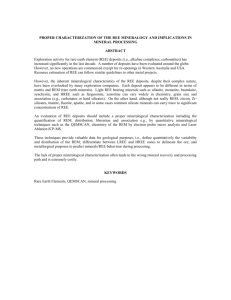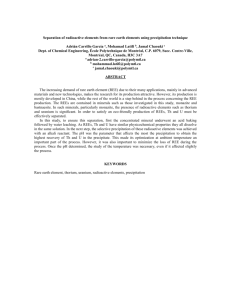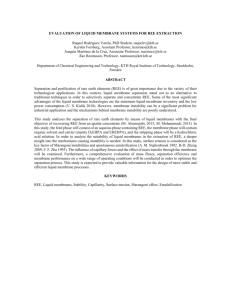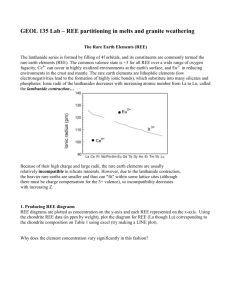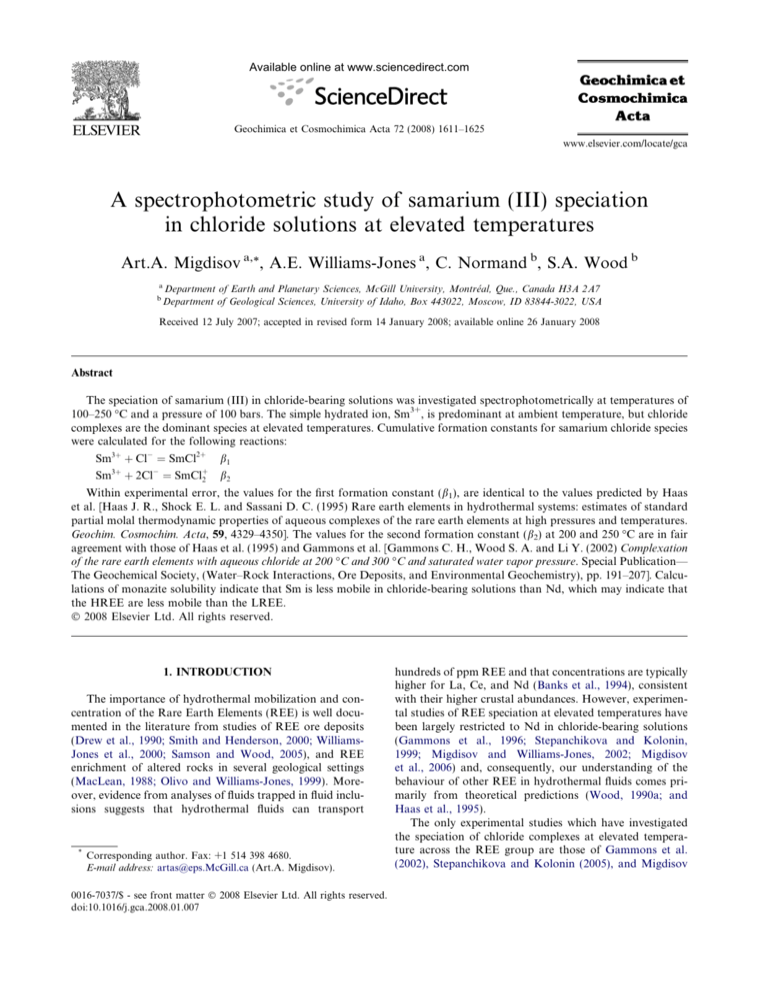
Available online at www.sciencedirect.com
Geochimica et Cosmochimica Acta 72 (2008) 1611–1625
www.elsevier.com/locate/gca
A spectrophotometric study of samarium (III) speciation
in chloride solutions at elevated temperatures
Art.A. Migdisov a,*, A.E. Williams-Jones a, C. Normand b, S.A. Wood b
a
b
Department of Earth and Planetary Sciences, McGill University, Montréal, Que., Canada H3A 2A7
Department of Geological Sciences, University of Idaho, Box 443022, Moscow, ID 83844-3022, USA
Received 12 July 2007; accepted in revised form 14 January 2008; available online 26 January 2008
Abstract
The speciation of samarium (III) in chloride-bearing solutions was investigated spectrophotometrically at temperatures of
100–250 °C and a pressure of 100 bars. The simple hydrated ion, Sm3+, is predominant at ambient temperature, but chloride
complexes are the dominant species at elevated temperatures. Cumulative formation constants for samarium chloride species
were calculated for the following reactions:
Sm3þ þ Cl ¼ SmCl2þ
Sm3þ þ 2Cl ¼ SmClþ
2
b1
b2
Within experimental error, the values for the first formation constant (b1), are identical to the values predicted by Haas
et al. [Haas J. R., Shock E. L. and Sassani D. C. (1995) Rare earth elements in hydrothermal systems: estimates of standard
partial molal thermodynamic properties of aqueous complexes of the rare earth elements at high pressures and temperatures.
Geochim. Cosmochim. Acta, 59, 4329–4350]. The values for the second formation constant (b2) at 200 and 250 °C are in fair
agreement with those of Haas et al. (1995) and Gammons et al. [Gammons C. H., Wood S. A. and Li Y. (2002) Complexation
of the rare earth elements with aqueous chloride at 200 °C and 300 °C and saturated water vapor pressure. Special Publication—
The Geochemical Society, (Water–Rock Interactions, Ore Deposits, and Environmental Geochemistry), pp. 191–207]. Calculations of monazite solubility indicate that Sm is less mobile in chloride-bearing solutions than Nd, which may indicate that
the HREE are less mobile than the LREE.
Ó 2008 Elsevier Ltd. All rights reserved.
1. INTRODUCTION
The importance of hydrothermal mobilization and concentration of the Rare Earth Elements (REE) is well documented in the literature from studies of REE ore deposits
(Drew et al., 1990; Smith and Henderson, 2000; WilliamsJones et al., 2000; Samson and Wood, 2005), and REE
enrichment of altered rocks in several geological settings
(MacLean, 1988; Olivo and Williams-Jones, 1999). Moreover, evidence from analyses of fluids trapped in fluid inclusions suggests that hydrothermal fluids can transport
*
Corresponding author. Fax: +1 514 398 4680.
E-mail address: artas@eps.McGill.ca (Art.A. Migdisov).
0016-7037/$ - see front matter Ó 2008 Elsevier Ltd. All rights reserved.
doi:10.1016/j.gca.2008.01.007
hundreds of ppm REE and that concentrations are typically
higher for La, Ce, and Nd (Banks et al., 1994), consistent
with their higher crustal abundances. However, experimental studies of REE speciation at elevated temperatures have
been largely restricted to Nd in chloride-bearing solutions
(Gammons et al., 1996; Stepanchikova and Kolonin,
1999; Migdisov and Williams-Jones, 2002; Migdisov
et al., 2006) and, consequently, our understanding of the
behaviour of other REE in hydrothermal fluids comes primarily from theoretical predictions (Wood, 1990a; and
Haas et al., 1995).
The only experimental studies which have investigated
the speciation of chloride complexes at elevated temperature across the REE group are those of Gammons et al.
(2002), Stepanchikova and Kolonin (2005), and Migdisov
1612
Art.A. Migdisov et al. / Geochimica et Cosmochimica Acta 72 (2008) 1611–1625
and Williams-Jones (2006). The latter two studies were devoted to the speciation of selected REE (Sm + Ho and Er,
respectively), whereas Gammons et al. (2002) considered all
the REE. However, Gammons et al. (2002) managed only
to determine the second stepwise formation constants
ðREECl2þ þ Cl ¼ REECl2 þ Þ, and the formation constants
determined by Stepanchikova and Kolonin (2005) are of
questionable reliability given the poor agreement of their
values for neodymium chloride species with those reported
by Gammons et al. (1996) and Migdisov and WilliamsJones (2002).
In order to evaluate variation in the stability of REE
chloride complexes with atomic number and to verify the
available theoretical estimates, Migdisov and WilliamsJones (2006) used the methodology employed by Migdisov
and Williams-Jones (2002) to determine formation constants for Er chloride complexes; the latter study yielded
formation constants that are in excellent agreement with
those of Gammons et al. (1996). The present study of Sm
chloride complexes builds on our earlier studies of Nd
and Er complexes, and, by using exactly the same methodology, ensures consistency among the datasets permitting
reliable comparison of the stability of these species.
tentatively attributed to hydrolysis at the temperatures of
the experiments. Chloride was introduced by adding appropriate quantities of NaCl (Fisher Scientific, A.C.S.). In order to determine the molar absorbance of Sm3+, absorption
spectra were also collected for eight chloride-free solutions
having total concentrations of Sm3+ ranging from 4.3102
to 3.2101 mol dm3. Concentrations reported here and
below are for solutions at 25 °C. The Sm concentrations
were verified by analyzing the experimental solutions using
neutron activation (Ecole Polytechnique, Montreal, Canada). In order to correct the spectra for background
absorption, the absorption of the cell filled with NanopureÒ
de-ionized water was recorded before each of the Sm spectra were collected. An estimate of the error of the measured
absorption values was obtained by repeated measurements
(several sets of 5–10 scans at each temperature) of the spectra of a solution having a total Sm concentration of
2.9101 mol kg1. The absorption values were reproducible to a tolerance (uncertainty in absolute units) that varied
from 0.01 to 0.02, increasing with temperature and decreasing with wavelength.
2. METHODS
As in Migdisov and Williams-Jones (2002, 2006), the spectra collected for chloride-free ClO4-based solutions were
attributed entirely to the absorbance of hydrated Sm3+ ions.
This interpretation was based on a study by Choppin et al.
(1966), who demonstrated that the perchloric ion does not
form spectroscopically detectable complexes with REE at
concentrations below 6 mol dm3, and the fact that the perchloric ion is transparent over the range of wavelengths investigated. The molar absorbances of hydrated Sm3+ were
calculated from the concentration of Sm3+ in chloride-free
solutions using the Beer–Lambert law:
The study described in this paper was conducted in a
high-temperature, flow-through, ultraviolet (UV)-visible
spectroscopic cell, constructed from grade 4 titanium alloy,
which is equipped with sapphire windows sealed using GraflexÒ (polymerized graphite) o-rings. Spectra were recorded
at temperatures of 25, 100, 150, 200, and 250 °C and a pressure of 100 bars. Temperature was controlled by an Omega
CN-2001 regulator (±0.5 °C) and pressure using a solution
delivery system, consisting of a HP 1050-Ti HPLC pump,
PEEK and Ti capillaries, and a PEEK back-pressure regulator. This ensured that the experimental solutions were
only in contact with chemically inert materials. The path
length (0.98 cm) was determined by a calibration procedure
involving measurements of the absorption of a
5103 mol dm3 potassium iodide solution in a standard
1 cm quartz cuvette and in the flow-through cell at 25 °C.
Changes in the optical path length with temperature were
calculated from the coefficients of thermal expansion for
titanium and sapphire.
Spectrophotometric measurements were made at 0.5-nm
intervals between 300 and 500 nm using a Cary 100 doublebeam spectrophotometer. Absorption spectra were collected for 33 solutions in which Sm concentrations ranged
from 4.3102 to 2.9101 mol dm3, and total chloride concentrations ranged from 1.51102 to 1.09 mol dm3. The
solutions were prepared by dissolving REactonÒ-grade
samarium (III) oxide (Alfa Aesar, 99.99%) in NanopureÒ
de-ionized water acidified by Optima-grade perchloric acid
(Fisher Scientific) to a final pH25 °C of 1.56 to prevent
hydrolysis of samarium (Wood et al., 2002). This pH25°C
was selected on the basis of exploratory experiments, which
showed that the Sm–Cl solutions with pH25°C > 3 produce
spectra that are variably shifted to higher absorption values
compared to spectra for more acidic solutions; the shift is
3. RESULTS
A ¼ eSm3þ M Sm3þ l
ð1Þ
where A is the absorbance, e is the molar absorbance for
Sm3+, l is the path length, and M is the molar concentration
of Sm3+ in mol/dm3. As was the case for Nd3+ and Er3+
(Migdisov and Williams-Jones, 2002, 2006), molar absorbances decrease with increasing temperature (Fig. 1).
At 25 °C, the spectra collected for Cl-bearing solutions
are identical (within the accuracy of measurement) to those
collected for solutions free of chloride ions. However, at
higher temperatures, increasing the concentration of chloride ions resulted in a red shift of the spectra. Fig. 2 shows
this spectral shift for selected regions of the spectra (corrected for solvent and window absorbance) observed at
150 and 250 °C for solutions having the same concentration
of samarium and variable concentrations of the chloride
ion. The effect of temperature on the spectra of samarium
chloride solutions is illustrated in Fig. 3. It can be seen from
this figure that heating the solutions resulted in a visible red
shift of peak maxima for some spectral regions and a decrease in absorption intensity for all recorded peaks. We
therefore conclude that the systematic shift observed in an
isothermal series of solutions and the shift caused by heating of the solutions are closely related and reflect variations
in the stability of Sm(III) chloride complexes.
Molar absorbance / Abs mol-1cm-1
Samarium speciation in chloride-bearing solutions
1613
2.5
25 ˚C
100 ˚C
150 ˚C
200 ˚C
250 ˚C
2
1.5
1
0.5
0
300
320
340
360
380
400
420
440
460
480
500
Wavelength, nm
Molar absorbance / Abs mol-1cm-1
2.5
2
1.5
25 ˚C
100 ˚C
150 ˚C
200 ˚C
250 ˚C
1
0.5
0
380
390
400
410
420
430
Wavelength, nm
Fig. 1. Molar absorbances for Sm3+, measured at temperatures of 26, 100, 150, 200, and 250 °C and enlargements of selected parts of the
spectra.
4. DATA TREATMENT
4.1. Speciation model
The number of absorbing species was determined by calculating the ranks of an absorbance matrix corrected for
solvent and window absorbance for each temperature
investigated, which employs the singular value decomposition of the absorbance matrix (cf., Suleimenov and Seward,
2000). Singular value decomposition ([L,S,V] = SVD (A))
produces a diagonal matrix, S, characterizing tolerances
associated with each particular calculated rank, and returns
statistically reliable numbers of linear equations that describe the analysed absorbance matrix. Assuming a conventional linear model with respect to chemical composition,
each of the experimental measurements at any given wavelength is defined by:
A X
ei M i
¼
l
i
ð2Þ
where A is the absorbance, ei is the molar absorbance of the
corresponding species, l is the path length, and Mi is the molar concentration of the corresponding species. Assuming
that the species have identical molar absorbances, the ranks
of the absorbance matrices calculated at the corresponding
experimentally determined tolerances provide the number
of independently absorbing species in the experimental fluids
(for more details see Suleimenov and Seward, 2000; Migdisov
et al., 2006). As the experimentally determined uncertainties
in the absorption values varied from 0.010 to 0.020, the results of the rank calculations for these tolerance intervals
were taken to be the total number of absorbing species.
The ranks of the matrix for the interval 300–500 nm are 2
for 100 and 150 °C, and 3 for higher temperatures, indicating
1614
Art.A. Migdisov et al. / Geochimica et Cosmochimica Acta 72 (2008) 1611–1625
A 0.7
ΣSm=0.29 mol/dm 3
150 ºC
Absorbance / Abs cm-1
0.6
0.5
from ΣCl=0.24 to 1.08 mol/dm 3
0.4
0.3
ΣCl=0
0.2
0.1
0.0
380
390
400
410
420
430
Wavelength, nm
B
0.7
Absorbance / Abs cm-1
0.6
ΣSm=0.29 mol/dm 3
250 ºC
0.5
0.4
from ΣCl=0.24 to 1.08 mol/dm 3
0.3
0.2
ΣCl=0
0.1
0.0
380
390
400
410
420
430
Wavelength, nm
Fig. 2. Selected parts of spectra recorded at 250 °C and 150 °C for solutions containing 0.29 mol/dm3 RSm and chloride concentrations
ranging from 0.24 to 1.08 mol/dm3. The first line on the graph corresponds to a solution which does not contain chloride ions.
that there were only two to three absorbing samarium species
in the experimental solutions (Fig. 4). Given that complexes
involving hydroxide are unlikely to be important under
highly acidic conditions (e.g., Wood, 1990a; Wood et al.,
2002), and considering that the only REE species experimentally determined for Cl-bearing solutions at elevated
temperatures are REE3+, REECl2+ and REECl+ (cf.,
Gammons et al., 2002), we interpreted the absorbing species
to be Sm3+ and SmCl2+ at 100 and 150 °C, and Sm3+,
SmCl2+, and SmCl2 þ at 200 and 250 °C. In modeling Sm
speciation, we ignored SmCl3 0 and SmCl4 , which were
evaluated theoretically by Haas et al. (1995), and predicted
by them to be of very minor importance. Theoretically, we
also cannot exclude occurrence of the polynuclear
species SmmCln, especially given that relatively strong
concentrations of Sm (up to 0.29 M) were required to obtain appreciable absorbance values. In order to check this
possibility we repeated the rank analysis for absorbance
matrices from which values corresponding to those of
solutions with concentrations >4.3102 mol dm3 Sm
had been removed. For all temperatures, these calculations
returned essentially the same results as the analyses of the
original matrices, thereby demonstrating that increasing
the concentration of Sm does not result in the formation
of new species in the solutions. We have therefore chosen
to ignore polynuclear species in the speciation model employed for the data treatment. Finally, although all the
solutions contained Na+, ClO4 and Cl, these species
were ignored as they are transparent in the spectral region
investigated.
Samarium speciation in chloride-bearing solutions
1615
ΣCl=0.16 mol/dm 3
ΣSm=0.12 mol/dm 3
0.30
Absorbance / Abs cm-1
0.25
25 ºC
100 ºC
0.20
150 ºC
200 ºC
0.15
250 ºC
0.10
0.05
0.00
380
390
400
410
420
430
Wavelength, nm
Fig. 3. Selected parts of spectra recorded at 26, 100, 150, 200, and 250 °C for a solution with RCl of 0.16 mol/dm3 and a RSm of 0.12 mol/
dm3.
4.2. Derivation of formation constants
Equilibrium constants were calculated for the following
complexation reactions:
Sm3þ þ Cl ¼ SmCl2þ
log b1 ¼ log aSmCl2þ log aCl log aSm3þ
ð3Þ
and
Sm3þ þ 2Cl ¼ SmClþ
2
log b2 ¼ log aSmClþ2 2 log aCl log aSm3þ :
ð4Þ
As in earlier studies (e.g., Suleimenov and Seward, 2000;
Migdisov and Williams-Jones, 2002, 2006; Migdisov
et al., 2006), the calculations involving the Beer–Lambert
law employed molarity units, which were converted to
molality units during the calculation of formation
constants.
In order to ensure consistency with the data published
previously, the activity model employed in this study and
the parameters used were identical to those employed by
Gammons et al. (1996, 2002) and Migdisov and WilliamsJones (2002, 2006) to describe speciation of REE in Clbearing solutions. Individual ion activity coefficients were
calculated using the extended Debye–Hückel equation
(Helgeson, 1969):
pffiffi
A ½zi 2 I
pffiffi þ bc I
log ci ¼
ð5Þ
1þBa I
where I is the ionic strength, z is the charge, a is the distance
of closest approach, A and B are the Debye–Hückel coefficients and bc is the extended parameter for a NaCl-based
electrolyte (Helgeson et al., 1981). Following Gammons
et al. (1996), values of a for H+ and Cl were taken from
Kielland (1937), that for Sm3+ was set at 9 Å, and those
for SmCl2+ and SmCl2 þ were set at 4.5 Å.
Following the method described by Suleimenov and
Seward (2000), and used in our earlier studies (Migdisov
and Williams-Jones, 2002; Migdisov et al., 2006), the vector
of equilibrium constants and the matrix of the molar extinction coefficients were determined via successive minimization of the function:
ffi
vffiffiffiffiffiffiffiffiffiffiffiffiffiffiffiffiffiffiffiffiffiffiffiffiffiffiffiffiffiffiffiffiffiffiffiffiffiffiffiffiffiffiffiffiffiffiffiffiffiffiffiffiffi
2
u
!2 3
uX
K
calc
Aobs
A
u I 4X
ik
ik
5
U ¼t
Aobs
ik
i¼1
k¼1
ð6Þ
where i is the wavelength, I is the total number of wavelengths at which measurements were made, and K is the
number of solutions. The variable Acalc
is the calculated
ik
absorbance, and is a function of the concentrations of the
absorbing species and their molar absorbances, whereas
Aobs
ik is the experimentally determined absorbance.
The calculations involved several cycles of iteration,
which minimized U (Eq. 6) with respect to the formation
constants. The algorithm employed in the minimization
was the Nelder–Mead simplex search described by Nelder
and Mead (1965), and Dennis and Woods (1987). Each of
the iterations involved calculation of the equilibrium concentrations of Sm3+, SmCl2+, SmCl2 þ , and Cl using initial
guesses of the formation constants b1 and b2 and the total
concentrations of Sm and Cl in the solutions investigated.
Ion pairing of both NaCl and HCl was accounted for in
the data treatment (Tagirov et al., 1997; Sverjensky et al.,
1616
Art.A. Migdisov et al. / Geochimica et Cosmochimica Acta 72 (2008) 1611–1625
10
10
9
9
8
8
100 ºC
6
6
5
4
5
4
3
3
2
2
1
1
0
0
0.01
0.02
Tolerance
0.01
0.03
10
10
9
9
0.02
Tolerance
0.03
8
8
150 ˚C
7
7
250 ˚C
6
6
Rank
Rank
200 ºC
7
Rank
Rank
7
5
4
5
4
3
3
2
2
1
1
0
0
0.01
0.02
Tolerance
0.03
0.01
0.02
Tolerance
0.03
Fig. 4. The results of rank calculations for the absorbance matrix. The rank represents the number of independent linear equations in the
absorption matrix, i.e., the number of absorbing species (see text for further explanation).
1997). The concentrations of Sm species were used to deconvolute the absorbance matrix and to produce values of
molar absorbances for each of the experimental wavelengths. The algorithm used in these calculations is described in detail in Migdisov et al. (2006) and employs the
approaches developed by Hug and Sulzberger (1994) and
Boily and Suleimenov (2006). At the end of each of the iterations, the values of the molar absorbance were used to
model spectra of the experimental solutions (Acalc
ik ), and to
calculate U (Eq. 6), which represents the deviations of the
modeled spectra from those recorded during the experiment. Fig. 5 shows results of the de-convolution of peaks
at 150 and 250 °C. The values of the optimized formation
constants are listed in Table 1 and are illustrated in Fig. 6.
Uncertainties associated with each of the formation constants were determined by calculating the overall error associated with a set of spectra and building an error function as
part of the procedure for optimizing the formation constants (cf. Migdisov and Williams-Jones, 2002). The distribution of the overall error for the treatment of the spectra
was modeled using the relationship:
vffiffiffiffiffiffiffiffiffiffiffiffiffiffiffiffiffiffiffiffiffiffiffiffiffiffiffiffiffiffiffiffiffiffiffiffiffiffiffiffiffiffiffiffiffiffiffiffiffiffiffiffiffiffi
i
uPI hPK obs
calc 2
u i¼1
k¼1 Aik Aik
u
Overall Error ¼ 100 t
ð7Þ
PI hPK obs 2 i
i¼1
k¼1 Aik
where I is the total number of wavelengths at which measurements were made and K is the number of solutions. The values of the overall error were compared with the accuracy of
the spectral measurements, which was calculated from the
values of the tolerance (see speciation model):
vffiffiffiffiffiffiffiffiffiffiffiffiffiffiffiffiffiffiffiffiffiffiffiffiffiffiffiffiffiffiffiffiffiffiffi
ffi
u PI PK
2
u i¼1
k¼1 tol
i
Accuracy ¼ 100 tP hP
I
K
obs 2
i¼1
k¼1 Aik
ð8Þ
where tol is the minimum tolerance required for the given
speciation model (see rank calculations). The range of values of the formation constant for which the overall error
was lower than the accuracy of the measurements yielded
the uncertainties listed in Table 1. These uncertainties are
similar to those calculated for Er–Cl formation constants
(Migdisov and Williams-Jones, 2006), and vary from
±0.11 to ±0.13 log units except that for b2 at 200 °C, which
is somewhat higher (±0.2). As for erbium (Migdisov and
Williams-Jones, 2006), we relate the relatively large uncertainty associated with the determination of b2 at 200 °C
to the facts that at this temperature, concentrations of
SmCl2 þ in the experimental solutions are low and the shifts
in the spectra caused by the presence of SmCl2 þ approach
the accuracy of the spectral recording.
Molar absorbance / Abs mol-1cm-1
Samarium speciation in chloride-bearing solutions
2.0
150 ºC
1.8
SmCl2+
1.6
1.4
1.2
1.0
0.8
0.6
0.4
Sm3+
0.2
0.0
380
390
400
410
420
430
Molar absorbance / Abs mol-1cm-1
Wavelength, nm
2.0
1.8
1.6
SmCl2+
250 ºC
1.4
SmCl2+
1.2
1.0
0.8
0.6
0.4
Sm3+
0.2
0.0
380
390
400
410
420
430
Wavelength, nm
Fig. 5. Molar absorbances for Sm3+, SmCl2+ and SmCl2 þ
obtained from the de-convolution of the spectra.
Table 1
Values of the formation constants for SmCl2+ and SmCl2 þ
(reactions 3 and 4, respectively) obtained in this study
T (°C)
log b1
log b2
25
100
150
200
250
—
1.00 ± 0.13
1.40 ± 0.11
2.28 ± 0.11
3.28 ± 0.13
—
—
—
3.18 ± 0.24
4.46 ± 0.11
1617
ment at 200 °C, the data of Stepanchikova and Kolonin
(2005) show a weaker temperature dependence than our
data and the predictions of Haas et al. (1995). Furthermore, extrapolation of the data of Stepanchikova and
Kolonin (2005) to the standard reference temperature
(298 K) yields values which are substantially higher than
that measured directly by other researchers (e.g., see the
review of Wood, 1990b). The same observation applies
to values of the formation constant reported by these
authors for Nd chloride species (Stepanchikova and Kolonin, 1999), and it is thus possible that there was a systematic error in their measurement of the spectra or treatment
of the data (cf., discussion in Migdisov and WilliamsJones, 2002). Unfortunately, Stepanchikova and Kolonin
(2005) do not describe the experimental methodology
and data treatment in sufficient detail for the sources of
disagreement to be identified. The values of the first formation constant obtained in our study are very close to the
predictions of Haas et al. (1995). The temperature dependence of b1 is slightly steeper than that of Haas et al.
(1995). However, the differences in b1 are sufficiently small
that they can be easily accounted for by our experimental
errors and the uncertainties associated with the method
employed by Haas et al. (1995) for their theoretical predictions. By contrast, the earlier estimates of Wood (1990a)
for b1 diverge sharply with increasing temperature from
our experimentally determined values, and at 250 °C are
separated by roughly 2 log units.
Values for the second formation constant for samarium
chloride (b2) have been reported by Gammons et al. (2002),
Stepanchikova and Kolonin (2005), Haas et al. (1995), and
Wood (1990a) did not report estimates for b2 (Table 3 and
Fig. 6). The differences between these datasets are considerably larger than for b1. The only value determined experimentally by Gammons et al. (2002) was the stepwise
formation constant at 200 °C (log Ks = 0.23 ± 0.3). These
authors therefore used theoretical estimates for log b1 to
calculate values of b2, and consequently the error for this
constant is relatively large. In order to make a more reliable
comparison of our data to those of Gammons et al. (2002),
we calculated the value of the stepwise formation constant
from our data as follows:
log Ks ¼ log b2 log b1 ¼ 0:90 0:33:
5. DISCUSSION
5.1. Comparisons to other studies
The results of this study were compared to those obtained spectroscopically by Stepanchikova and Kolonin
(2005), those obtained by Gammons et al. (2002) at
200 °C using the indirect solubility method, the theoretical
predictions of Haas et al. (1995) and Wood (1990a), and
those reported for Nd and Er chloride complexes by
Migdisov and Williams-Jones (2002, 2006). As is evident
from Fig. 6 and Table 2, which summarizes the values of
the first formation constant from different sources, the values for the constants obtained by Stepanchikova and
Kolonin (2005) are similar to those derived in this study.
However, although the two studies are in perfect agree-
Based on this comparison, SmCl2 þ is more stable than predicted by Gammons et al. (2002). Our data also suggest that
SmCl2 þ is more stable than predicted by Haas et al. (1995)
and Stepanchikova and Kolonin (2005), with the difference
in b2 reaching an order of magnitude at 250 °C. As they do
for b1, the data of Stepanchikova and Kolonin (2005) indicate a weaker dependence for b2 than the data obtained in
our study.
Table 4 and Figs. 7 and 8 show the values of the formation constants for the different REE chloride complexes at
elevated temperature available from the different sources
mentioned above. It can be seen from Fig. 6 that the values
of the formation constant for REECl2+ determined in our
studies at temperatures P200 °C decrease with increasing
atomic number and are very similar to the data of Haas
et al. (1995) for HREE, i.e., from Gd to Lu. For the light
1618
Art.A. Migdisov et al. / Geochimica et Cosmochimica Acta 72 (2008) 1611–1625
3.5
this study
3
1
2
Log
2.5
1.5
Stepanchikova and
Kolonin, 2005
1
Haas et al, 1995
0.5
Wood, 1990
0
0
50
100
150
200
250
300
T ºC
5
this study
4.5
Stepanchikova and
Kolonin, 2005
2
3.5
Log
4
3
2.5
Haas et al, 1995
2
1.5
170
190
210
230
250
270
Fig. 6. Values of the optimized formation constants obtained in this study and those reported in the literature.
Table 2
A comparison of the values of log b1 obtained in this study with
those recommended by others authors
T (°C)
This study
25
100
150
200
225
250
—
1.00
1.40
2.28
—
3.28
Stepanchikova and
Kolonin (2005)
Haas et al.
(1995)
Wood
(1990a)
1.44
1.73
2.26
2.46
—
0.30
1.06
1.64
2.26
2.60
2.96
0.36
0.62
0.81
1.04
—
1.33
Table 3
A comparison of the values of log b2 obtained in this study with
those recommended by others authors
T (°C)
This study
Stepanchikova and
Kolonin (2005)
Haas et al.
(1995)
200
225
250
3.18
—
4.46
3.05
3.40
—
2.61
3.10
3.64
REE, the values for log b1 predicted by Haas et al. (1995)
are lower than our values. By contrast, at temperatures below 200 °C, our data suggest that log b1 increases with
increasing atomic number, which is the opposite to that
predicted by Haas et al. (1995). At all temperatures considered, the largest disagreements between the predictions of
Haas et al. (1995) and our values are for Nd species. However, our log b1 values for Nd species based on spectroscopic data are in nearly perfect agreement with those of
Gammons et al. (1996) which were obtained using an entirely different method (solubility). We therefore conclude
that the data of Haas et al. (1995) underestimate the stability of LREECl2+ at temperatures higher than 200 °C and
overestimate it at 150 °C and lower temperature.
Fig. 8 illustrates dependencies available from different
sources at 250 and 200 °C for the stepwise formation constant of REECl2 þ . As is the case for REECl2+, our values
for the second stepwise formation constant are very similar
to those predicted by the data of Haas et al. (1995) for the
HREE, but deviate to higher values at lower atomic number.
Samarium speciation in chloride-bearing solutions
1619
Table 4
The values of logarithms of the formation constants for Nd-, Sm- and Er-chloride complexes in aqueous solutions
Nd3+ + Cl = NdCl2+
T (°C)
[1]
[2]
Sm3+ + Cl = SmCl2+
[3]
log b1 ¼ log aREECl2þ log aCl log aREE3þ
100
0.58
0.66
1.48
150
1.22
1.31
1.73
200
2.25
2.17
2.13
225
2.83
—
—
250
3.4
3.22
2.44
3þ
Nd
þ 2Cl ¼ NdCl2
[1]
[2]
[4]
[5]
[0]
[3]
[4]
[6]
[4]
1.07
1.65
2.27
2.61
2.98
0.69
0.89
1.13
—
1.45
1.00
1.40
2.28
—
3.28
1.44
1.73
2.26
2.46
—
1.06
1.64
2.26
2.60
2.96
0.88
1.59
2.34
—
3.09
1.05
1.65
2.31
3þ
þ
Sm
[3]
2 log aCl log aREE3þ
log b2 ¼ log a
200
3.15
2.52
2.54
225
3.91
—
—
250
4.64
4.45
3.49
þ 2Cl ¼ SmCl2
þ
Er
3þ
3.06
þ 2Cl ¼ ErCl2
þ
[4]
[5]
[0]
[3]
[4]
[6]
[4]
2.71
3.20
3.74
—
—
—
3.18
—
4.46
3.05
3.4
—
2.61
3.10
3.64
2.95
2.77
3.32
3.94
REEClþ
2
NdCl2þ þ Cl ¼ NdCl2 þ
[1]
Er3+ + Cl = ErCl2+
[2]
log Ks = log b2 log b1
200
0.9
0.35
4.12
SmCl2þ þ Cl ¼ SmCl2 þ
ErCl2þ þ Cl ¼ ErCl2 þ
[7]
[3]
[4]
[0]
[3]
[7]
[4]
[6]
[7]
[4]
0.35
0.41
0.43
0.9
0.79
0.23
0.35
0.61
0.4
0.46
The data sources are: [0] this study; [1] Migdisov and Williams-Jones (2002); [2] Gammons et al. (1996); [3] Stepanchikova and Kolonin (2005);
[4] Haas et al. (1995); [5] Wood (1990a); [6] Migdisov and Williams-Jones, 2006; [7] Gammons et al. (2002).
The stepwise formation constants determined by Gammons
et al. (2002) predict a trend with atomic number similar to
that obtained in the present study (except the values determined for Ho and Tb, which depart from this trend). Our
data therefore suggest that the data of Haas et al. (1995) likely
underestimate the stability of LREECl2 þ at 200 and 250 °C.
In summary, our study indicates that aqueous samarium
chloride species are more stable than predicted at temperatures >150 °C and less stable than predicted at <150 °C.
The formation constants determined experimentally in
this and our previous studies for chloride complexes of
REE (Migdisov and Williams-Jones, 2002, 2006; this study)
were fitted to the modified Ryzhenko–Bryzgalin model (Ryzhenko, 1981; also see Shvarov and Bastrakov, 1999; and
Migdisov and Williams-Jones, 2007); the resulting values of
the model parameters are listed in Table 5. Based on this
model, Gibbs free energies of REE chloride species were calculated for temperatures from 25 to 250 °C in 25 °C increments and were fitted (using a weighted least-square
method) to the HKF model of Tanger and Helgeson
(1988). The HKF model parameters recommended by Haas
et al. (1995) were used as initial guesses. As no experimental
information is available on the pressure dependence of the
stability of REE–Cl species, the optimization was performed
only for the parameters responsible for the temperature
dependence of Gibbs free energy (S298 and c1). Free energies
were fitted to an error of 60.05 kJ/mol; the latter value was
used as a criterion in choosing the minimum number of
parameters to fit. For example, optimization of only one
parameter (S298) resulted in deviations of theoretical values
from experimental values of as much as 4 kJ/mol, but
increasing the number of parameters optimized to 3 (S298,
c1 and c2) did not improve the quality of the fit significantly.
The results of the optimization are summarized in Table 6
and were used for the calculations discussed in the next
section.
5.2. Application to natural systems
The greater mobility of the LREE relative to the HREE
implied by the stability relationships for REE chloride species documented in this study suggests that these elements
may fractionate during hydrothermal alteration. In order
to evaluate this possibility, we modeled the solubility of monazite in hypothetical hydrothermal fluids with chloride concentrations of up to 2 mol/kg H2O. Monazite is well suited
for this purpose because it is the most commonly observed
REE-rich mineral in nature, occurring as an accessory phase
in a wide variety of igneous, sedimentary and metamorphic
rocks. It is also commonly the principal source of the REE
in some major ore deposits (e.g., the Bayan Obo REE–Fe–
Nb deposit, China; Chao et al., 1997). Most importantly,
REE phosphates are among the few REE phases for which
the thermodynamic data needed to calculate reaction paths
at elevated temperatures are available. In our previous study
(Migdisov and Williams-Jones, 2006), we calculated the solubility of Nd and Er phosphates in order to illustrate the potential fractionation of REE during dissolution of monazite.
However, at the time of this publication, data were only available on the stability of the Nd end-member, and we had to
make the questionable assumption that the thermochemical
properties of Nd- and Er-bearing phosphates are the same.
Since then, new data have been published by Popa and Konings (2006), which allow the stability of LaPO4 to GdPO4 to
be reliably calculated. We have therefore revised our calculations of REE phosphate solubility in chloride solutions.
1620
Art.A. Migdisov et al. / Geochimica et Cosmochimica Acta 72 (2008) 1611–1625
Gammons et al.,
1996
3.6
this study,
Migdisov and Williams-Jones, 2002, 2006
3.4
1
3
Log
3.2
2.8
Haas et al., 1995
2.6
2.4
250 ºC
Stepanchikova and Kolonin, 2005
2.2
2
La
Ce
Pr
Nd
Pm
Sm
Eu
Gd
Tb
Dy
this study,
Migdisov and
Williams-Jones, 2002, 2006
2.7
Ho
Er
Tm
Yb
Lu
Haas et al., 1995
2.5
Log
1
2.3
2.1
Gammons et al.,
1996
1.9
Stepanchikova and Kolonin, 2005
1.7
200 ºC
1.5
La
Ce
Pr
Nd
Pm
Sm
Eu
Gd
Tb
Dy
Ho
Er
Tm
Yb
Lu
Stepanchikova and Kolonin, 2005
1.9
Haas et al., 1995
1.8
1.7
1
1.5
Log
1.6
1.4
Gammons et al.,
1996
1.3
this study,
Migdisov and
Williams-Jones, 2002, 2006
1.2
1.1
150 ºC
1
La
Ce
Pr
Nd
Pm
Sm
Eu
Gd
Tb
Dy
Ho
Er
Tm
Yb
Lu
Fig. 7. Distribution of the values of the first cumulative formation constant across the REE group of elements.
Given that there are still no thermodynamic data available for phosphates of REE heavier than Gd, the LREE
and HREE were represented by Nd and Sm, respectively.
Although it would have been desirable to consider REE
Samarium speciation in chloride-bearing solutions
1621
2
Stepanchikova and Kolonin, 2005
1.8
1.6
Gammons et al.,
1996
this study,
Migdisov and
Williams-Jones, 2002, 2006
Log K s
1.4
1.2
1
0.8
0.6
Haas et al., 1995
250 ºC
0.4
0.2
0
La Ce
Pr
Nd Pm Sm Eu
Gd Tb Dy Ho Er Tm Yb Lu
Stepanchikova and Kolonin, 2005
2
this study,
Migdisov and
Williams-Jones, 2002, 2006
Log K s
1.5
200 ˚C
1
0.5
0
Haas et al., 1995
Gammons et al.,
2002
-0.5
La Ce
Pr
Nd Pm Sm Eu Gd Tb Dy Ho Er Tm Yb Lu
Fig. 8. Distribution of the values of the stepwise formation constant across the REE group of elements.
Table 5
Values of the parameters for the Ryzhenko–Bryzgalin model based
on the data presented in this study and Migdisov and WilliamsJones (2002, 2006)
Reaction
3+
2+
Nd + Cl = NdCl
Sm3+ + Cl = SmCl2+
Er3+ + Cl = ErCl2+
Nd3þ þ 2Cl ¼ NdCl2 þ
Sm3þ þ 2Cl ¼ SmCl2 þ
Er3þ þ 2Cl ¼ ErCl2 þ
pK(298)
A(zz/a)
B(zz/a)
0.309
0.309
0.309
0.031
0.043
0.043
2.811
2.04
1.522
2.783
2.083
2.097
938.5
551.8
313.1
687.9
350.9
415.6
further apart in the periodic table, this approach has the
advantage over our earlier study of considering the effects
of the differing thermochemical properties of the solid
phase.
Monazite solid-solution, in which Sm is the predominant REE, is very rare and monazite-(Sm) has been described as a new species only recently (Masau et al.,
2002). In the vast majority of cases, the lighter REE (Ce
in particular) are predominant and a Nd/Sm ratio of
approximately 10 appears to be common (Zhu and
O’Nions, 1999). For the purpose of this paper, monazite
Table 6
Values of the parameters for the HKF model for REE chloride species based on the data presented in this study and Migdisov and WilliamsJones (2002, 2006)
DG298
DH298
S298
a1 * 10
a2 * 102
a3
a4 * 104
c1
c2 * 104
xo * 105
Z
NdCl2+
SmCl2+
ErCl2+
NdCl2 þ
SmCl2 þ
ErCl2 þ
192400
203000
44.64
0.6746
9.4228
9.439
2.3894
94.2429
6.7094
1.4006
2
190900
201700
34.48
0.5006
8.9988
9.2743
2.4069
54.0308
6.7552
1.4192
2
191700
205400
36.17
0.6062
9.2588
9.381
2.3961
33.0702
2.6303
1.5579
2
223400
241500
12.71
2.3933
1.9354
6.5057
2.6989
45.7032
10.4138
0.6388
1
221800
240300
4.66
2.5888
1.4617
6.3276
2.7185
9.8647
10.5032
0.6644
1
222600
244700
16.86
2.4799
1.7256
6.427
2.7076
15.2715
2.455
0.8449
1
1622
Art.A. Migdisov et al. / Geochimica et Cosmochimica Acta 72 (2008) 1611–1625
was modeled as solid solutions consisting of monazite–(Nd)
and monazite–(Sm). The two phases have identical space
group symmetry, and because Nd and Sm have similar
a
ionic radii, we assumed that solid solution between these
two end-members is ideal (ideal site mixing; Montel et al.,
1989). The modeling was performed using two composi-
Nd
-6.0
Sm
0.1 m Cl
2 m Cl
Log ∑REE
-6.5
-7.0
-7.5
-8.0
-8.5
0
50
100
150
200
250
300
T ºC
b -7.0
200 ºC
Log concentration (molal)
-7.5
-8.0
-8.5
log Nd 3+
-9.0
log NdCl2+
log NdCl 2+
-9.5
-1.2
log Sm3+
-1.0
-0.8
-0.6
-0.4
-0.2
0.0
0.2
+
log SmCl 2
Log free chloride ion (molal)
c
log SmCl2+
-7.0
250 ºC
Log concentration (molal)
-7.5
-8.0
-8.5
-9.0
-9.5
-10.0
-1.2
-1.0
-0.8
-0.6
-0.4
-0.2
Log free chloride ion (molal)
0.0
0.2
Fig. 9. The variation in REE concentration and speciation of fluids in equilibrium with monazite–(Nd0.5–Sm0.5) as a function of NaCl
concentration at a constant HCl concentration of 103 m. (a) Total solubility of Sm and Nd in 0.1 and 2 m solution of NaCl; (b) and (c) the
speciation of REE as a function of NaCl concentration at 200 and 250 °C, respectively.
Samarium speciation in chloride-bearing solutions
tions; Nd0.5Sm0.5PO4 and Nd0.9Sm0.1PO4. The monazite–
(REE) solid solutions were reacted with 1 kg H2O containing a constant HCl concentration of 103 m and NaCl concentrations varying between 0.1 and 2.0 m. Calculations
were carried out for temperatures of 25, 100, 150, 200
and 250 °C, and a pressure of 100 bar.
Monazite has extremely low solubility in solutions containing <2.0 m NaCl. Consequently, very high water/solid
mass ratios are required to cause a significant shift in the
composition of the solid solution. At 250 °C, a water/solid
mass ratio in excess of 2,000,000 is needed to change the
composition of the solid solution by >1 mol %. Under this
unlikely condition, the composition of the solid is shifted
a
1623
towards the monazite–(Sm) end-member, and the magnitude of the shift increases with an increase in the water/solid
mass ratio.
The solubility of the monazite-(REE) solid solution (expressed as R REE concentration) in a 0.1 m NaCl solution
is 3 107 m in equilibrium with Nd0.5Sm0.5PO4 and
5.4 107 in equilibrium with Nd0.9Sm0.1PO4, at 25 °C.
With increasing temperature, these concentrations decrease,
reaching minimum values of 2.9 108 m and 6.9 108 at
200 °C, respectively, and then increase; at 250 °C, the corresponding concentrations are 3.3 108 m and 8.4 108 m. By contrast, the solubility of the two monazite–
(REE) solid solutions in 2.0 m NaCl decreases continuously
7
0.1 m Cl
∑Nd/∑Sm
6
0.5 m Cl
5
1 m Cl
4
3
0
50
100
150
200
250
150
200
250
T (C)
90
b
80
70
∑Nd/ ∑Sm
60
50
40
30
20
10
0
0
50
100
T (C)
Fig. 10. The variation as a function of temperature in the ratios of RNd and total RSm in aqueous solutions in equilibrium with (a) monazite–
(Nd0.5–Sm0.5) and (b) monazite–(Nd0.9Sm0.1PO4).
1624
Art.A. Migdisov et al. / Geochimica et Cosmochimica Acta 72 (2008) 1611–1625
between 25 (8.4 107 and 1.7 106 m, respectively) and
250 °C (1.2 107 and 2.7 107 m, respectively), i.e., their
solubility is retrograde, consistent with experimental data reported by Poitrasson et al. (2004). At all temperatures, neodymium is the more soluble of the two REE. The RNd/
RSm ratio of the fluid in equilibrium with Nd0.5Sm0.5PO4 varies between 6.5 and 3.6 at 25 °C for NaCl concentrations of
0.1 m and 2.0 m, respectively, and at 250 °C the corresponding ratios are 5.6 and 5.4. For a fluid in equilibrium with
Nd0.9Sm0.1PO4, the RNd/RSm ratio is an order of magnitude
higher, varying between 76.1 and 76.6 at 25 °C and between
50.2 and 52.2 at 250 °C for NaCl concentrations of 0.1 m
and 2.0 m, respectively. The predominant aqueous neodymium species are Nd3+ and NdCl2+ at temperatures below and
above 200 °C, respectively, for both solid solutions modeled
(Fig. 9a and b).
The calculations suggest that, where the REE content of
chloride-rich hydrothermal solutions is controlled by the
presence of monazite–(REE), the proportion of heavier
REE in the fluid will increase progressively as temperature
is decreased to 200 °C, and decrease with further cooling
below this temperature (Fig. 10). This, in turn, suggests
that in REE deposits where monazite is the chief ore mineral and the hydrothermal system evolved by cooling
through a relatively large temperature interval down to
about 200 °C, later forming REE phases might be more
HREE-enriched.
It needs to be emphasised that the model presented here
is highly simplistic and its predictions should therefore be
treated with caution. Furthermore, it might not even apply
to REE further apart than Nd and Sm in the periodic table,
even if thermodynamic data for the solids were available,
because the HREE would tend to form phosphate minerals
having the structure of xenotime rather than monazite.
These limitations notwithstanding, the model does nevertheless serve to show that aqueous REE complexation
may play an important and in some cases dominant role
in the fractionation of REE in nature.
6. CONCLUSIONS
The experimental data obtained in this study show that
the predominant species of Sm in chloride-bearing aqueous
solutions are Sm3+, SmCl2+ and SmCl2 þ and that chloride
complexes predominate over the simple ion at temperatures
above 150 °C for a wide range of Cl concentrations. Moreover, they also suggest that the data of Haas et al. (1995)
are likely to underestimate the stability of Sm and LREE in
chloride-bearing solutions at temperatures higher than
200 °C and overestimate them at temperatures <150 °C.
Finally, calculations of monazite solubility indicate that Sm
is less mobile in chloride-bearing solutions than Nd, a finding
which may help explain the fractionation of the REE in
natural hydrothermal systems.
ACKNOWLEDGMENTS
The study was supported by a NSERC Discovery grant to
A.E.W.-J. The authors are grateful to J.F. Boily, C. Gammons,
and J.R. Haas for thoughtful and constructive reviews.
REFERENCES
Banks D. A., Yardley B. W. D., Campbell A. R. and Jarvis K. E.
(1994) REE composition of an aqueous magmatic fluid: a fluid
inclusion study from the Capitan Pluton, New Mexico, U.S.A.
Chem. Geol. 113, 259–272.
Boily J.-F. and Suleimenov O. M. (2006) Extraction of chemical
speciation and molar absorption coefficients with well-posed
solutions of Beer’s law. J. Solution Chem. 35, 917–926.
Chao E. C. T., Back J. M., Minkin J. A., Tatsumoto M., Junwen
W., Conrad J. E. and McKee E. H. (1997) The Sedimentary
Carbonate-Hosted Giant Bayan Obo REE–Fe–Nb Ore Deposit of
Inner Mongolia, China: A Cornerstone Example for Giant
Polymetallic Ore Deposits of Hydrothermal Origin. U.S. Geological Survey, Bulletin 2143.
Choppin G. R., Kelly D. A. and Ward E. E. (1966) Effect of
changes in the ionic medium on the stability constant of
Eu(NO3)2+. AEC Access. Nos., (ORO-1797-2), 21p.
Dennis J. E., Jr. and Woods D. J. (1987) New Computing
Environments: Microcomputers in Large-Scale Computing (ed.
A. Wouk). SIAM, pp. 116—122.
Drew L. J., Oingrun M. and Weijun S. (1990) The Bayan Obo ironrare-earth-niobium deposit, Inner Mongolia, Cina. Lithos 26,
43–65.
Gammons C. H., Wood S. A. and Li Y. (2002) Complexation of the
rare earth elements with aqueous chloride at 200 °C and 300 °C
and saturated water vapor pressure. Special Publication—The
Geochemical Society, (Water–Rock Interactions, Ore Deposits,
and Environmental Geochemistry), pp. 191–207.
Gammons C. H., Wood S. A. and Williams-Jones A. E. (1996) The
aqueous geochemistry of the rare earth elements and yttrium:
VI. Stability of neodymium chloride complexes from 25 to
300 °C. Geochim. Cosmochim. Acta 60, 4615–4630.
Haas J. R., Shock E. L. and Sassani D. C. (1995) Rare earth
elements in hydrothermal systems: estimates of standard partial
molal thermodynamic properties of aqueous complexes of the
rare earth elements at high pressures and temperatures.
Geochim. Cosmochim. Acta 59, 4329–4350.
Helgeson H. C., Kirkham D. H. and Flowers G. C. (1981)
Theoretical prediction of the thermodynamic behavior of
aqueous electrolytes at high pressures and temperatures: IV.
Calculation of activity coefficients, osmotic coefficients, and
apparent molal and standard and relative partial molal properties to 600 °C and 5 kb. Am. J. Sci. 281, 1249–1516.
Helgeson H. C. (1969) Thermodynamics of hydrothermal systems
at elevated temperatures and pressures. Am. J. Sci. 267, 729–
804.
Hug S. J. and Sulzberger B. (1994) In situ fourier transform
infrared spectroscopic evidence for the formation of several
different surface complexes of oxalate on TiO2 in the aqueous
phase. Langmur 10, 3587–3597.
Kielland J. (1937) Individual activity coefficients of ions in aqueous
solutions. J. Am. Chem. Soc. 59, 1675–1678.
MacLean W. H. (1988) Rare earth mobility at constant inter REE
ratios in the alteration zone at the Phelps Dodge massive Sulfide
Deposit, Mattagami, Quebec. Miner. Deposita 23, 231–238.
Masau M., Cerný P., Cooper M. A., Chapman R. and Grice J. D.
(2002) Monazite–(Sm), a new member of the monazite group
from the Annie Claim #3 granitic pegmatite, southeastern
Manitoba. Can. Mineral. 40, 1649–1655.
Migdisov Art. A. and Williams-Jones A. E. (2002) A spectrophotometric study of Neodymium (III) complexation in chloride
solutions. Geochim. Cosmochim. Acta 66, 4311–4323.
Migdisov Art. A. and Williams-Jones A. E. (2006) A spectrophotometric study of erbium (III) speciation in chloride solutions at
elevated temperatures. Chem. Geol. 234, 17–27.
Samarium speciation in chloride-bearing solutions
Migdisov Art. A., Reukov V. V. and Williams-Jones A. E. (2006) A
spectrophotometric study of neodymium(III) complexation in
sulfate solutions at elevated temperatures. Geochim. Cosmochim. Acta 70, 983–992.
Migdisov Art. A. and Williams-Jones A. E. (2007) An experimental
study of solubility and speciation of NdF3 in high-temperature
F-bearing hydrothermal solutions. Geochim. Cosmochim. Acta
71, 3056–3069.
Montel J. M., Lhote F. and Claude J. M. (1989) Monazite end
members and solid solutions: synthesis, unit-cell characteristics,
and utilization as microprobe standards. Mineral. Mag. 53,
120–123.
Nelder J. A. and Mead R. (1965) A simplex method for function
minimization. Comput. J. 7, 308–313.
Olivo G. R. and Williams-Jones A. E. (1999) Hydrothermal REErich eudialyte from the Pilanesberg Complex, South Africa.
Can. Mineral. 37(3), 653–663.
Poitrasson F., Oelkers E., Schott J. and Montel J.-M. (2004)
Experimental determination of synthetic NdPO4 monazite endmember solubility in water from 21 °C to 300 °C: Implications
for rare earth element mobility in crustal fluids. Geochim.
Cosmochim. Acta 68, 2207–2221.
Popa K. and Konings R. J. M. (2006) High-temperature heat
capacities of EuPO4 and SmPO4 synthetic monazites. Thermochim. Acta 445, 49–52.
Ryzhenko B. N. (1981) Thermodynamics of Equilibriums in Hydrothermal Solutions (Termodinamika Ravnovesii v Gidrotermal’nykh Rastvorakh). Nauka, Moscow, USSR, 191p.
Samson I. M. and Wood S. A. (2005) The rare earth elements:
Behaviour in hydrothermal fluids and concentration in hydrothermal mineral deposits, exclusive of alkaline settings. In RareElement Geochemistry and Mineral Deposits, GAC Short
Course Notes 17 (eds. R. L. Linnen and I. M. Samson).
Geological Association of Canada, pp. 269–297.
Shvarov Y. and Bastrakov E. (1999) HCh: a software package for
geochemical equilibrium modelling, User’s guide. Australian
Geological Survey Organization Record 1999/25, 61p.
Smith M. P. and Henderson P. (2000) Preliminary fluid inclusion
constraints on fluid evolution in the Bayan Obo Fe–REE–Nb
deposit, Inner Mongolia, China. Econ. Geol. 95, 1371–1388.
Stepanchikova S. A. and Kolonin G. R. (1999) Spectrophotometric
study of complexation of neodymium in chloride solutions at
temperatures up to 250 °C. Zh. Neorg. Khim. 44, 1744–1751.
1625
Stepanchikova S. A. and Kolonin G. R. (2005) Spectrophotometric
study of Nd, Sm, and Ho complexation in chloride solutions at
100–250 °C. Russ. J. Coord. Chem. 31, 193–202.
Suleimenov O. M. and Seward T. M. (2000) Spectrophotometric
measurements of metal complex formation at high temperatures: the stability of Mn(II) chloride species. Chem. Geol. 167,
177–192.
Sverjensky D. A., Shock E. L. and Helgeson H. C. (1997)
Prediction of the thermodynamic properties of aqueous metal
complexes to 1000 °C and 5 kb. Geochim. Cosmochim. Acta 61,
1359–1412.
Tagirov B., Zotov A. V. and Akinfiev N. N. (1997) Experimental
study of dissociation of HCl from 350 to 500 °C and from 500
to 2500 bars. Thermodynamic properties of HCl°(aq). Geochim.
Cosmochim. Acta 61, 4267–4280.
Tanger, IV, J. C. and Helgeson H. C. (1988) Calculation of the
thermodynamic and transport properties of aqueous species at
high pressures and temperatures: revised equations of state for
the standard partial molal properties of ions and electrolytes.
Am. J. Sci. 288(1), 19–98.
Williams-Jones A. E., Samson I. M. and Olivo G. R. (2000) The
genesis of hydrothermal fluorite-REE deposits in the Gallinas
Mountains, New Mexico. Econ. Geol. 95, 327–341.
Wood S. A. (1990a) The aqueous geochemistry of the rare-earth
elements and yttrium. 2. Theoretical predictions of speciation in
hydrothermal solutions to 350 °C at saturation water vapor
pressure. Chem. Geol. 88, 99–125.
Wood S. A. (1990b) The aqueous geochemistry of the rare-earth
elements and yttrium. 1. Review of available low-temperature
data for inorganic complexes and the inorganic REE speciation
of natural waters. Chem. Geol. 82, 159–186.
Wood S. A., Palmer D. A., Wesolowski D. J. and Benezeth P.
(2002) The aqueous geochemistry of the rare earth elements and
yttrium. Part XI. The solubility of Nd(OH)3 and hydrolysis of
Nd3+ from 30 to 290 °C at saturated water vapor pressure with insitu pH measurement. Special Publication—The Geochemical
Society, (Water–Rock Interactions, Ore Deposits, and Environmental Geochemistry), pp. 229–256.
Zhu X. K. and O’Nions R. K. (1999) Monazite chemical
composition: some implications for monazite geochronology.
Contrib. Mineral. Petr. 137, 351–363.
Associate editor: Johnson R. Haas

